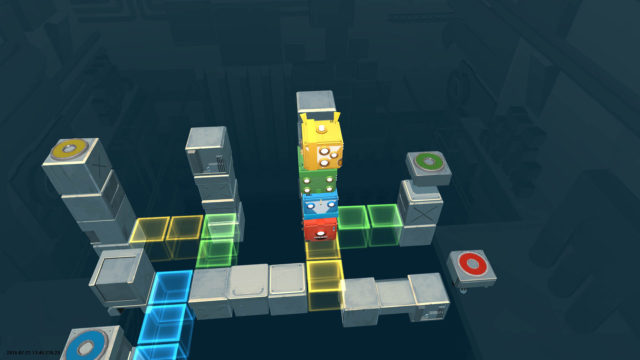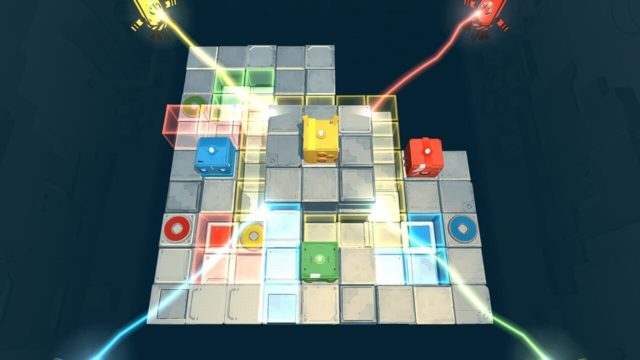Many clever gameplay ideas; great co-op, equal parts challenging and rewarding; humorous Story mode
Lack of camera control; gameplay occasionally disrupted by wonky physics; controlling multiple cubes at once might hurt your brain
The puzzle genre has long been one of the most interesting in gaming, offering an immense level of variety ranging from the falling blocks in Tetris to the wildly innovative gameplay and narrative of Portal. Compared to many other genres, it seems less defined by mechanics and more focused on giving people a chance to stretch their brain by any means necessary. Death Squared from Australian developer SMG Studio embraces the inherent freedom of the genre and while it might not be destined to be an all-time classic, it does manage to consistently deliver some really clever ideas.
The core gameplay in Death Squared revolves around guiding several differently colored cubes through stages filled with a variety of obstacles and traps. The concept is simple, but the developers managed to come up with many interesting ideas to make the process both challenging and rewarding. As you move the cubes around and press color coordinated switches, you will trigger a variety of reactions, from changes in the level’s layout to potentially lethal traps. Each cube needs to get to a specific tile to win the stage, and if any cube dies, you have to start over. You will likely die a great deal, but thankfully the respawn time is mercifully short.
Most people will likely start with the Story mode, which can be played alone or with one other player. This mode features 80 stages that mostly do a good job of ramping up the difficulty while introducing many new tweaks to the game, mostly in the form of new obstacles and traps. If anything, the game actually comes up with too many new ideas, as not all of them feel as well thought out as others. Really, the game would have benefited from further exploring the best mechanics rather than changing it up so often. Also, the Story mode is aptly named as there is a narrative featuring a guy named Dave who works for a monolithic company alongside an AI companion who helps him test the smarts of the little cubes you play as. The writing is generally quite funny, and while it might lean a little too heavy on humorous references to famous science fiction properties, the game is definitely better off with the voice over.

Beyond the Story mode, you have Party mode and The Vault. Party mode adds more colored cubes to the game, thus allowing more players. Whether you have two people controlling two cubes each or four people each responsible for one cube, the Party levels require a great deal of communication and cooperation between players, so it’s one of those games that can be entertaining regardless of whether it brings your friends together or tears them apart. As for the Vault, it contains additional levels not found in the other modes that are significantly more challenging and will likely add many more hours of playtime for those who really get into the game.
While much of this likely sounds intriguing at the very least, I must unfortunately report that there are several issues that add considerable frustration to Death Squared. The most consistent problem I had was actually with the game’s physics. As you move your cubes around, they can quite easily get their corners caught on objects in the environment, including other cubes; at its least annoying, this issue might just slow you down as you round a corner, but at its worst, you can wind up pushing other cubes off of switches or into otherwise avoidable traps. Furthermore, there were a few times when the momentum of moving platforms would cause my cubes to fall off and die in a way that seemed unintentional. This issue can also be compounded by the fact you have no control over the camera. The view of most stages is just fine, but occasionally you will encounter problems, especially on levels where the camera angle doesn’t do a good job of letting you see depth, thus making it harder to line up some maneuvers.
Perhaps the most frustrating issue stems from the fact that there are some levels that could have benefited greatly from checkpoints or a rewind feature. Later stages can get surprisingly long and complex while also falling victim to some of the aforementioned problems. For some, these levels might prove insurmountable roadblocks, not because they can’t be beaten, but because their difficulty feels cheap rather than earned. Few things are more frustrating than figuring out the solution to a problem and then having to play it out over and over again due to cheap deaths. In fact, there was at least one level that I’m pretty sure was broken if approached according to how the developers designed it, but thankfully could still be beaten in a manner that really should have killed your cubes.

The only other major problem I think might be somewhat conditional. Whenever you are controlling multiple cubes, it seems that the game can prove quite taxing on your brain. Each cube is controlled by one analog stick, and there is something about controlling one cube with the right stick and the other with the left stick that feels incredibly odd when the cubes wind up on the opposite sides of one another. A friend of mine with ridiculously good dexterity and hand eye coordination had no problems, but after a few hours I would often feel like my brain’s wiring had crossed and I would frequently wind up moving one cube when I intended to move the other. Some might find that this adds to the challenge, while others might hate the game because of it. Either way, it’s worth taking note of.
Finally, the game works fairly well in terms of the audio and visual experience. The approach to both is very simple and clean and I think it works especially well for the look of the game. The environments are quite purposefully bland in an industrial sort of way, but the cubes are actually rather cute and have quite a bit of character. As for the sound, the voice acting is good and the music is generally pleasant and appropriate, but a bit more variety would have been appreciated.
Death Squared is a solid puzzle game that displays a great deal of creativity on the part of its developers; despite the simple concept they managed to come up with many clever ideas to make the proceedings equal parts challenging and rewarding. Though there is quite a bit of ingenuity at play, the game ultimately does suffer from a handful of small, but frustrating problems. With a bit more focus on further developing the best mechanics and more polish in the controls, Death Squared really could have been something great. However, as the game stands, it is still a worthwhile puzzler that should please gamers looking for a unique cooperative experience.




 ShareThis
ShareThis





